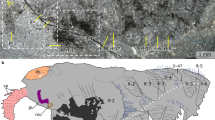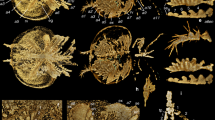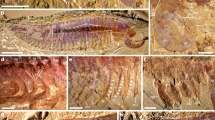Abstract
The composition of the arthropod head has been one of the most controversial topics in zoology, with a large number of theories being proposed to account for it over the last century1. Although fossils have been recognized as being of potential importance in resolving the issue2,3, a lack of consensus over their systematics4,5 has obscured their contribution. Here, I show that a group of previously problematic Cambrian arthropods from the Burgess Shale and Chengjiang faunas form a clade close to crown-group euarthropods, the group containing myriapods, chelicerates, insects and crustaceans6. They are characterized by modified or even absent endopods, and two pre-oral appendages. Comparison with reconstructions of the crown-group euarthropod ground plan6 and recent investigations into onychophorans7,8 demonstrates that these two appendages are the first antenna (of extant crustaceans) and a more anterior appendage associated with an ocular segment. The latter appendage has been reduced in all crown-group euarthropods. Its most likely relic is as a component of the labrum9. These fossils thus tie together results from disparate living groups (onychophorans and euarthropods).
This is a preview of subscription content, access via your institution
Access options
Subscribe to this journal
Receive 51 print issues and online access
$199.00 per year
only $3.90 per issue
Buy this article
- Purchase on Springer Link
- Instant access to full article PDF
Prices may be subject to local taxes which are calculated during checkout


Similar content being viewed by others
References
Rempel, J. G. The evolution of the insect head: the endless dispute. Q. Entomol. 11, 7–25 (1975)
Dewel, R. A. & Dewel, W. C. The place of tardigrades in arthropod evolution. Syst. Assoc. Sp. Vol. 55 109–123 (1997)
Chen, J. Y., Edgecombe, G. D., Ramsköld, L. & Zhou, G. Head segmentation in Early Cambrian Fuxianhuia: implications for arthropod evolution. Science 268, 1339–1343 (1995)
Wills, M. A., Briggs, D. E. G., Fortey, R. A. & Wilkinson, M. The significance of fossils in understanding arthropod evolution. Verh. Deut. Zool. Gessell. 88, 203–215 (1995)
Simonetta, A. M. & Della Cave, L. in The Early Evolution of Metazoa and the Significance of Problematic Taxa (eds Simonetta, A. M. & Conway Morris, S.) 189–244 (Cambridge Univ. Press, Cambridge, 1991)
Walossek, D. in Proc. 4th Int. Crustacean Congr. (eds Schram, F. R. & von Vaupel Klein, J. C.) 3–27(Brill Academic, Leiden, 1999)
Eriksson, B. J. & Budd, G. E. The cephalic nerves of the Onychophora and their bearing on our understanding of head segmentation of stem-group evolution of Arthropoda. Arth. Struct. Dev. 29, 197–209 (2001)
Eriksson, B. J., Tait, N. N. & Budd, G. E. Head development in the onychophoran Euperipatoides kanangrensis with particular reference to the central nervous system. J. Morphol. (in the press)
Haas, M. S., Brown, S. J. & Beeman, R. W. Pondering the procephalon: the segmental origin of the labrum. Dev. Genes. Evol. 211, 89–95 (2001)
Whittington, H. B. Early arthropods, their appendages and relationships. Syst. Ass. Spec. 12, 253–268 (1979)
Walossek, D. & Müller, K. J. Upper Cambrian stem-lineage crustaceans and their bearing upon the monophyletic origin of Crustacea and the position of Agnostus. Lethaia 23, 409–427 (1990)
Edgecombe, G. D. & Ramsköld, L. Relationships of Cambrian Arachnata and the systematic position of Trilobita. J. Paleontol. 73, 263–287 (1999)
Budd, G. E. The morphology and evolutionary significance of Kerygmachela kierkegaardi Budd (Buen Formation, Lower Cambrian, North Greenland). Trans. R. Soc. Edinb. Earth Sci. 89, 249–290 (1999)
Whittington, H. B. The lobopodian animal Aysheaia pedunculata Walcott, Middle Cambrian, Burgess Shale, British Columbia. Phil. Trans. R. Soc. Lond. B 284, 165–197 (1978)
Richter, S. & Scholtz, G. Phylogenetic analysis of the Malacostraca (Crustacea). J. Zool. Syst. Evol. Res. 39, 113–136 (2001)
Bruton, D. L. & Whittington, H. B. Emeraldella and Leanchoilia, two arthropods from the Burgess Shale, Middle Cambrian, British Columbia. Phil. Trans. R. Soc. Lond. B 300, 553–585 (1983)
Walossek, D. The Upper Cambrian Rehbachiella and the phylogeny of Branchiopoda and Crustacea. Fossils Strata 32, 1–202 (1993)
Giribet, G., Edgecombe, G. D. & Wheeler, W. C. Arthropod phylogeny based on eight molecular loci and morphology. Nature 413, 157–161 (2001)
Hou, X.-G. & Bergström, J. Arthropods of the Lower Cambrian Chengjiang fauna, southwest China. Fossils Strata 45, 1–116 (1997)
Briggs, D. E. G. The morphology, mode of life and affinities of Canadaspis perfecta (Crustacea: Phyllocarida), Middle Cambrian, Burgess Shale, British Columbia. Phil. Trans. R. Soc. Lond. B 281, 439–487 (1978)
Briggs, D. E. G. & Collins, D. A Middle Cambrian chelicerate from Mount Stephen, British Columbia (Canada). Palaeontology 31, 779–798 (1988)
Hou, X.-G., Bergström, J. & Ahlberg, P. Anomalocaris and other large animals in the Lower Cambrian Chengjiang fauna of southwest China. GFF 117, 3–183 (1995)
Budd, G. E. Stem-group arthropods from the Lower Cambrian Sirius Passet fauna of North Greenland. Syst. Assoc. Sp. Vol. 55, 125–138 (1997)
Dewel, R. A., Budd, G. E., Castano, D. F. & Dewel, W. C. The organization of the subesophageal nervous system in tardigrades: insights into the evolution of the arthropod hypostome and tritocerebrum. Zoologischer Anzeiger 238, 191–203 (1999)
Hou, X.-G. New rare bivalved arthropods from the Lower Cambrian Chengjiang fauna, Yunnan, China. J. Palaeontol. 73, 102–116 (1999)
Bousfield, E. L. A contribution to the natural classification of Lower and Middle Cambrian arthropods: food-gathering and feeling mechanisms. Amphipacifica 2, 3–33 (1995)
Scholtz, G. Evolution of developmental patterns in arthropods—the analysis of gene expression and its bearing on morphology and phylogenetics. Zoology 103, 99–111 (2001)
Aguinaldo, A. M. A. et al. Evidence for a clade of nematodes, arthropods and other moulting animals. Nature 387, 489–493 (1997)
Telford, M. J. & Thomas, R. A. Expression of homeobox genes shows chelicerate arthropods retain their deutocerebral segment. Proc. Natl Acad. Sci. USA 95, 10671–10675 (1998)
Winter, G. Beiträge zur Morphologie und embryologie des vorderen Körperabschnitts (Cephalosoma) der Pantopoda Gerstaecker, 1863. Z. Zool. Syst. Evol. 18, 27–61 (1980)
Swofford, D. L. PAUP: Phylogenetic Analysis Using Parsimony, Version 3.1.1 (Illinois Natural History Survey, Champaign, Illinois, 1993)
Acknowledgements
This work grew out of a collaboration with R. A. Dewel, whom I thank for discussions that helped shape many of the ideas contained herein. D. Waloszek and J. Eriksson have also provided much help and insight. I also thank J. Bergström, H. Xianguang, D. Collins and D. Erwin for allowing access to material. The comments of G. Edgecombe substantially improved the paper. This work was funded by the Swedish Research Council (VR).
Author information
Authors and Affiliations
Ethics declarations
Competing interests
The author declares that he has no competing financial interests.
Supplementary information
Rights and permissions
About this article
Cite this article
Budd, G. A palaeontological solution to the arthropod head problem. Nature 417, 271–275 (2002). https://doi.org/10.1038/417271a
Received:
Accepted:
Issue Date:
DOI: https://doi.org/10.1038/417271a
This article is cited by
-
A multiscale approach reveals elaborate circulatory system and intermittent heartbeat in velvet worms (Onychophora)
Communications Biology (2023)
-
The velvet worm brain unveils homologies and evolutionary novelties across panarthropods
BMC Biology (2022)
-
Ordovician opabiniid-like animals and the role of the proboscis in euarthropod head evolution
Nature Communications (2022)
-
Neuroanatomy in a middle Cambrian mollisoniid and the ancestral nervous system organization of chelicerates
Nature Communications (2022)
-
Exites in Cambrian arthropods and homology of arthropod limb branches
Nature Communications (2021)
Comments
By submitting a comment you agree to abide by our Terms and Community Guidelines. If you find something abusive or that does not comply with our terms or guidelines please flag it as inappropriate.



